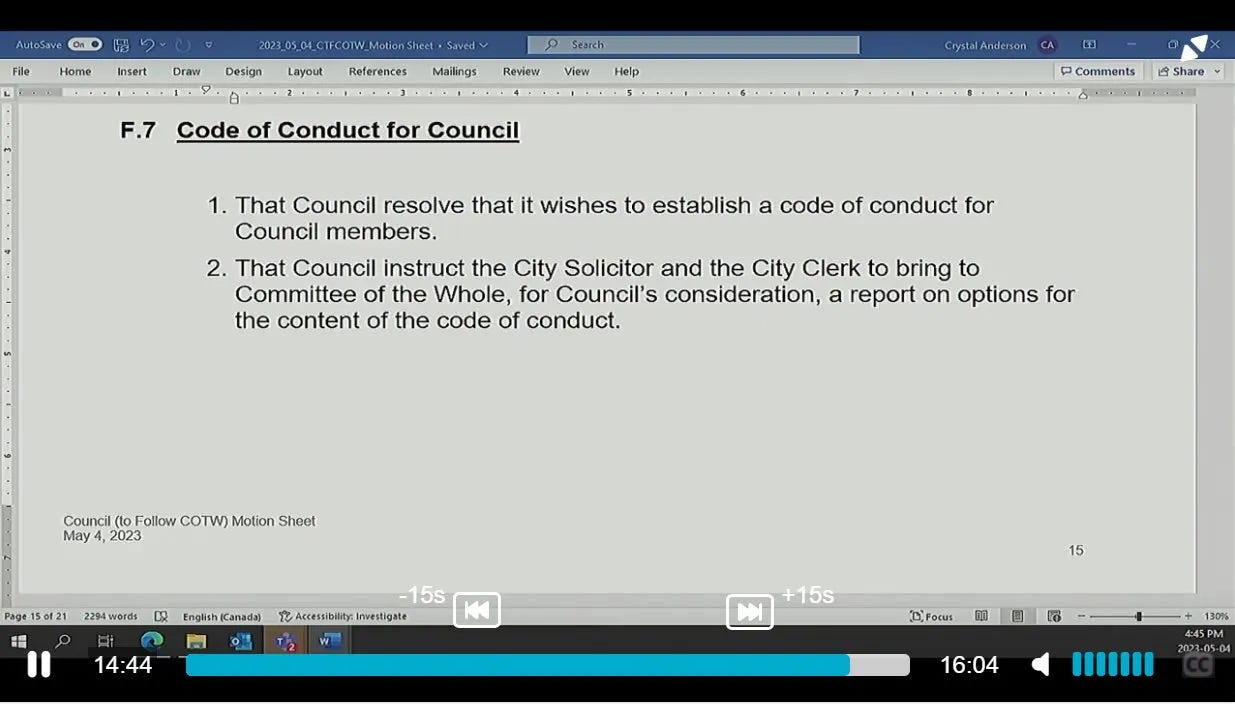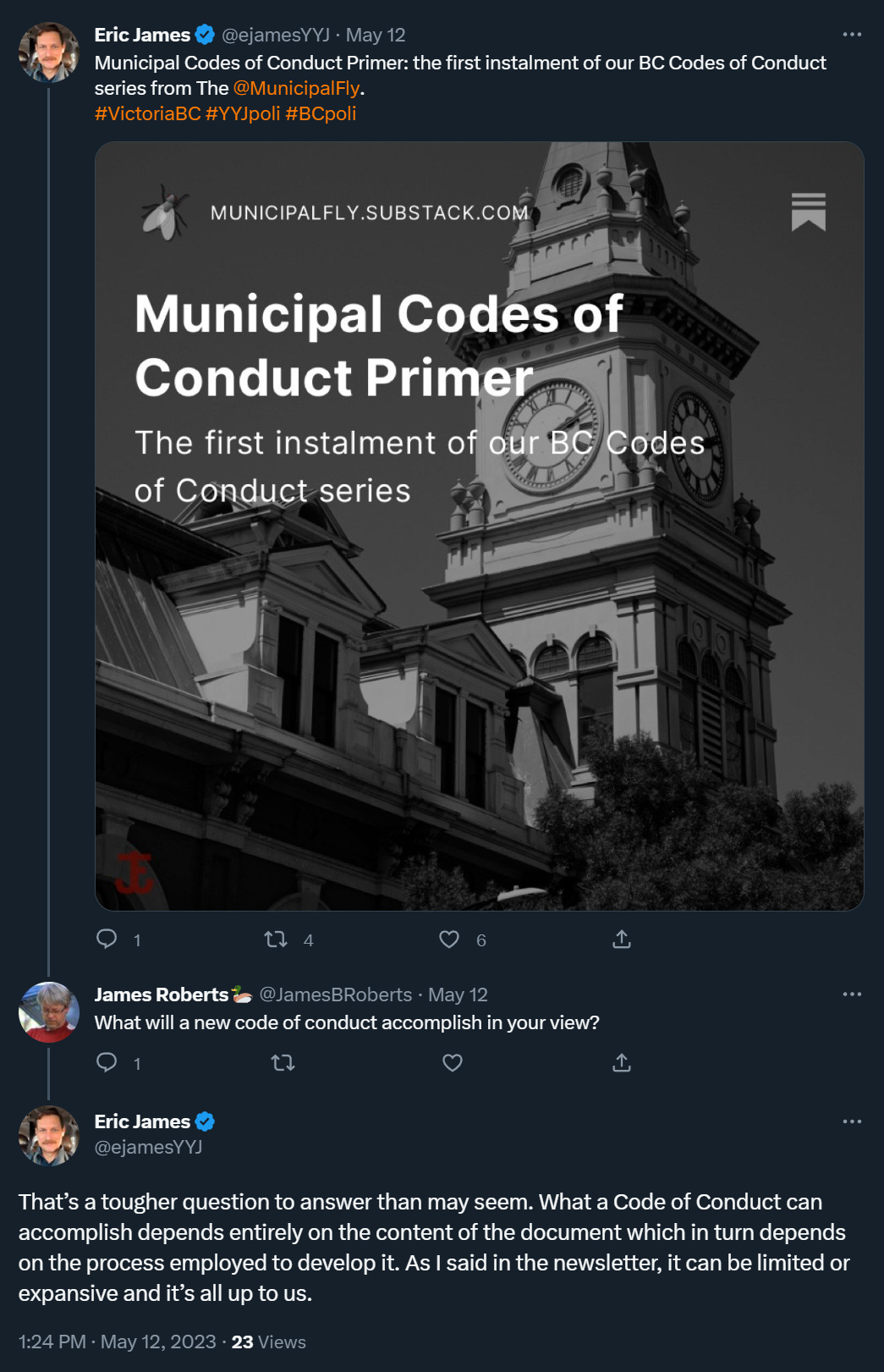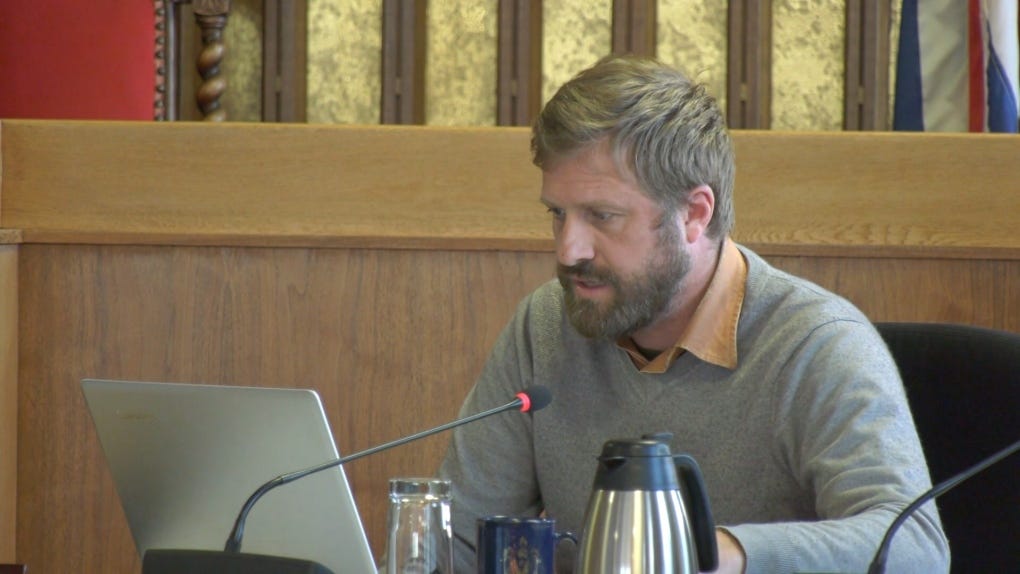The Purpose of a Municipal Code of Conduct
The second instalment of our BC Codes of Conduct series
Editor’s Note: This is the second instalment of a series of newsletters that will be published by The Municipal Fly exploring the topic of municipal Codes of Conduct in British Columbia.
In this newsletter we are going to explore the purpose of a municipal code of conduct policy with two tangible examples from the Victoria City Council over the last few years.

In our last newsletter on the topic we looked at the high level development and implementation of code of conduct legislation in British Columbia. We learned that the Victoria City Council had decided to implement its own code of conduct after the coming into force of amendments to the Community Charter that required every council in British Columbia to decide/review a code of conduct within three months of an election.
And while we were late in addressing the matter, and the motion itself seemed to lack any real detail on the plan to develop the document, the council did move unanimously to have staff report back on the possible contents of a code of conduct.
After posting a link to the Codes of Conduct Primer on Twitter, I was asked by James Roberts what I thought a code of conduct would accomplish in Victoria. This is a valid question that is worthy of a serious answer. And that is the purpose of this addition to the series on Codes of Conduct in British Columbia.
It turns out that when developing a code of conduct our elected officials are not being left in the dark. There are, in fact, numerous resources available to them and their staff which is endorsed by the Ministry of Municipal Affairs. A key document in this arsenal is the Companion Guide: Getting Started on a Code of Conduct for Your Council/Board which was created by the Working Group on Responsible Conduct (WGRC). The document is called a “companion guide” because it is meant to be read and used alongside the Model Code of Conduct: Getting Started on a Code of Conduct for Your Council/Board and which are both available online on the Ministry’s website.
We are just getting this newsletter off of the ground and need as much support as we can get. Please consider subscribing to the newsletter to show your support and get weekly updates sent every Friday morning directly to your email inbox.
The Model Code of Conduct is just that, an example document that can serve as a baseline for elected officials and their staff who are going through the process of creating a document for their own local jurisdiction. The Companion Guide is meant to dive a little deeper into the process and provides questions that officials can ask themselves as they consider each possible section and purpose of a code of conduct for their particular council. Included in the Companion Guide is a list of codes of conduct which already exist in jurisdictions throughout British Columbia. We are going to be relying on these documents during our assessment of a code of conduct for Victoria and so I will link them here:
I am going to use this list because they are actually what is suggested by the Ministry through the documentation readily available online and so to avoid any claim down the line that I am out to lunch with my claims that these provisions are possible within a code of conduct document for Victoria.
Those seven jurisdiction have on their books the provisions contained with those codes of conduct and so comparing them to situations that have happened in Victoria over the past few years as a means of demonstrating the purpose of a code of conduct is entirely justified.
Information and Privacy
Elected officials and their staff are exposed to a large amount of private and personal information in the regular course of their responsibilities. Constituents are in regular contact with elected officials and often sharing information which they believe will be protected and used only for official purposes. For example, they do not expect the use of email lists generated from city-wide engagement surveys to send out election campaign material or publishing personal information online by sharing screencaps of communications received from constituents.
This is exactly what happened with Ben Isitt while he was councillor in 2021 on three separate occasions. Not only did then-Councillor Isitt use email information to distribute what on the face appeared to be campaign related material to individuals who shared their contact information for another purpose entirely, but he engaged in what could be considered intimidating behaviour online openly that culminated in the sharing of personal information.
The City of Abbotsford has a great section dealing with this very issue under a schedule dealing with examples of unacceptable conduct.
Confidentiality and data security
4(1) Intentionally accessing unauthorized information, records or data on City devices;
(2) Unauthorized disclosure of confidential or personal information to a third party;
(3) Intentionally breaching the City’s network and data security systems;
(4) Intentionally leaking confidential information to the media or other local government stakeholders;
(5) Fraud;
(6) Theft of City resources and/or assets; and
(7) Criminal Code of Canada conviction while in office.
Now, would having a code of conduct have prevented this breach from taking place? Perhaps not. And luckily there were protections in place because Isitt was held accountable by the Information Officer of the city (and in the end by the voters themselves). But a major piece of the code of conduct process is education and awareness. The WGRC stresses that the document requires a training program alongside so that elected officials and staff can understand and acquaint themselves with the standards contained within the document.
This is why every example code of conduct from the list I provided above includes a very large section at the beginning defining all of the terms contained within the document itself. As I said in my previous newsletter on the topic, a code of conduct establishes expectations while not assuming that everyone in the room understands the meaning of the terms being used. Had we had a code of conduct in place, like perhaps the District of Saanich who had theirs since 2016, there could have been an education component alongside that then-Councillor Isitt would have participated in and would have better understood the use of email lists and information sharing online. With the education piece I do think that this whole situation could have been avoided.
Bullying and Harassment
Recall the MNP report which outlined a major issue within the internal workings of our local government. There was a specific mention of the behaviour of some elected officials toward staff:
Multiple members of Council also expressed concern with the tone of some Councillor interactions with staff in meetings, described as at times disrespectful and demotivating.
And that sometimes the behaviour could border on harassment:
Concerns with the adversarial and aggressive nature of some Councillor interactions with senior staff in meetings was also identified, to the point where some have characterized the behaviours as approaching the level of harassment.
A code of conduct does not just address the relationships and interactions between elected officials, it also addresses the relationships and interactions between elected officials and city staff. And the MNP was damning in exposing this sort of conduct inside of City Hall.
Dare I say it, we probably do not need any more reason than this simple report to demand a code of conduct for our city. Not only would the code of conduct have an education component which I mention above, but it would have reporting and enforcement mechanisms so that staff can report this behaviour and see a timely and appropriate response from a proper authority. And this is very important. Because we only found out about this because of a report done by an outside agency, and that is unacceptable. Harassment, bullying and intimidation of any sort must not be tolerated in our local government, period.
Under Part 2 of their code of conduct dealing with Standards and Values, the City of Vancouver has this provision which deals with this very issue:
e) respect: a member must treat members of the public, one another, and staff respectfully, without abuse, bullying or intimidation and ensure that the work environment is free from discrimination and harassment;
These are just two basic examples of issues that have arose over the last few years with our council that paint an example of the purpose of a code of conduct in Victoria. The education piece is tremendously important and would serve to assist our elected officials and city staff in understanding the concepts of privacy protection, social media use, official communications, and conflict of interest. This would empower them to make wise decisions over the course of their time in office regarding their conduct.
To close this newsletter off, one thing stands out for me at the end of researching and preparing for this piece. There is a list of seven jurisdictions (among many others throughout British Columbia) who have codes of conduct on their books. Many have had them before there was a requirement in provincial law. We should be somewhat ashamed that we do not have a code of conduct on our books. We should be ashamed to not be the company of those cities who have taken responsible conduct seriously and developed a policy that protects the integrity of our local governing system.
Despite issues arising and an outside agency identifying situations when a code of conduct would have assisted us, Victoria City Council remained slow to respond to the development of such a document. Even now, with the requirement being enshrined in law, we were late to address the issue and left a tremendous amount regarding the process and timeline to the imagination.
Newsletters in this series:
Municipal Codes of Conduct Primer
Editor’s Note: This is the first instalment of a series of newsletters that will be published by The Municipal Fly exploring the topic of municipal Codes of Conduct in British Columbia. In this newsletter we are going to present a primer on the concept of Codes of Conduct in British Columbia— where they came from, why they exist— and bring readers up to…











